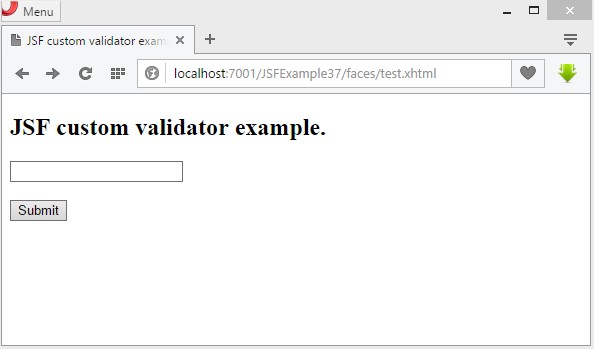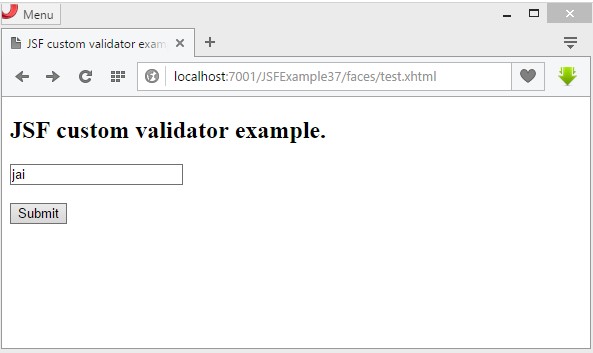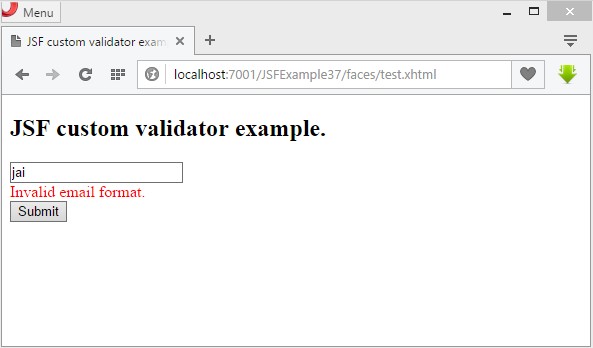Let us discuss how to create custom validator in JSF with example.
Steps to create custom validator in JSF:
1. First create a validator class by implementing javax.faces.validator.Validator interface
2. Override validate() method of above interface.
3. Assign a unique validator ID to the custom validator by using @FacesValidator annotation.
4. Use custom validator class to JSF component via f:validator tag.
Example:
test.xhtml
<?xml version="1.0" encoding="UTF-8"?> <!DOCTYPE html PUBLIC "-//W3C//DTD XHTML 1.0 Transitional//EN" "http://www.w3.org/TR/xhtml1/DTD/xhtml1-transitional.dtd"> <html xmlns="http://www.w3.org/1999/xhtml" xmlns:h="http://java.sun.com/jsf/html" xmlns:f="http://java.sun.com/jsf/core"> <h:head> <title>JSF custom validator example.</title> </h:head> <h:body> <h2>JSF custom validator example.</h2> <h:form> <h:inputText id="emailId" label="Email: " value="#{test.email}" required="true"> <f:validator validatorId= "com.w3schools.business.EmailValidator" /> </h:inputText> <br/> <h:message for="emailId" style="color:red" /> <br/> <h:commandButton value="Submit" action="success"/> </h:form> </h:body> </html> |
Test.java
import javax.faces.bean.ManagedBean; import javax.faces.bean.SessionScoped; /** * Managed bean. * @author w3schools */ @ManagedBean(name="test") @SessionScoped public class Test { private String email; public String getEmail() { return email; } public void setEmail(String email) { this.email = email; } } |
EmailValidator.java
import java.util.regex.Matcher; import java.util.regex.Pattern; import javax.faces.application.FacesMessage; import javax.faces.component.UIComponent; import javax.faces.context.FacesContext; import javax.faces.validator.FacesValidator; import javax.faces.validator.Validator; import javax.faces.validator.ValidatorException; @FacesValidator("com.w3schools.business.EmailValidator") public class EmailValidator implements Validator { private static final String EMAIL_PATTERN = "^[_A-Za-z0-9-]+(\\." + "[_A-Za-z0-9-]+)*@[A-Za-z0-9]+(\\.[A-Za-z0-9]+)*" + "(\\.[A-Za-z]{2,})$"; private Pattern pattern; private Matcher matcher; public EmailValidator(){ pattern = Pattern.compile(EMAIL_PATTERN); } public void validate(FacesContext context, UIComponent component, Object value) throws ValidatorException { matcher = pattern.matcher(value.toString()); if(!matcher.matches()){ FacesMessage msg = new FacesMessage("Email validation failed.", "Invalid email format."); msg.setSeverity(FacesMessage.SEVERITY_ERROR); throw new ValidatorException(msg); } } } |
welcome.xhtml
<?xml version="1.0" encoding="UTF-8"?> <!DOCTYPE html PUBLIC "-//W3C//DTD XHTML 1.0 Transitional//EN" "http://www.w3.org/TR/xhtml1/DTD/xhtml1-transitional.dtd"> <html xmlns="http://www.w3.org/1999/xhtml" xmlns:h="http://java.sun.com/jsf/html" xmlns:f="http://java.sun.com/jsf/core"> <h:head> <title>JSF custom validator example.</title> </h:head> <h:body> <h2>JSF custom validator example.</h2> <h3>Email: <h:outputText value="#{test.email}"/></h3> </h:body> </html> |
faces-config.xml
<?xml version="1.0" encoding="windows-1252"?> <faces-config version="2.0" xmlns="http://java.sun.com/xml/ns/javaee" xmlns:xi="http://www.w3.org/2001/XInclude" xmlns:xsi="http://www.w3.org/2001/XMLSchema-instance" xsi:schemaLocation="http://java.sun.com/xml/ns/javaee http://java.sun.com/xml/ns/javaee/web-facesconfig_2_0.xsd"> </faces-config> |
web.xml
<?xml version="1.0" encoding="UTF-8"?> <web-app version="3.0" xmlns="http://java.sun.com/xml/ns/javaee" xmlns:xsi="http://www.w3.org/2001/XMLSchema-instance" xsi:schemaLocation="http://java.sun.com/xml/ns/javaee http://java.sun.com/xml/ns/javaee/web-app_3_0.xsd"> <servlet> <servlet-name>faces</servlet-name> <servlet-class> javax.faces.webapp.FacesServlet <servlet-mapping> <servlet-name>faces</servlet-name> <url-pattern>/faces/*</url-pattern> </servlet-mapping> </web-app> |
URL:
http://localhost:7001/JSFExample37/faces/test.xhtml
Output:

Enter value.

Click Submit button.

Download this example.